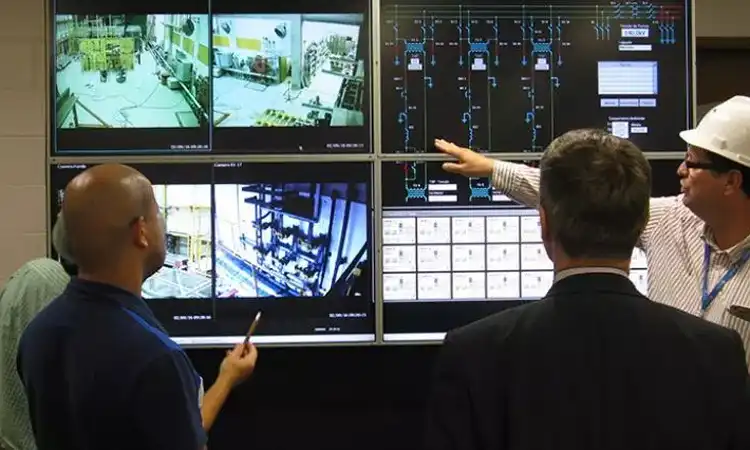Building automation systems have become an integral part of the construction process, making it easier for architects to manage their projects and contractors to complete them on time. These systems can also help you save money by reducing labor costs and keeping your building safe. In this article, we’ll cover the basics of building automation systems: what they are, how they work, and how they can help you build better.
What is a Building Automation System?
A building automation system (BAS) is a system that controls the operation of a building from one or more remote locations outside of the building itself. BAS’s are made up of sensors that monitor the building’s environmental conditions, such as temperature, humidity, pressure, and light levels. They use this information to send signals back to the central base station, where they can be analyzed by a computer program running on a server computer inside your home or business.
Automated building control systems can be very sophisticated and have many different functions. Some common functions include:
- Security monitoring
- Security camera coverage
- Emergency response systems (including fire alarms and security guards)
- Lighting control
Here are the basics of building automation systems explained PDF file
How does Building Automation System Work?
BAS systems are a great way to save money on energy and maintenance costs. They can also make your home more comfortable, safe, and secure.
These systems use sensors that monitor your home’s temperature, humidity, sound levels, and movement. The sensors relay this information to a central computer that can adjust certain aspects of your home’s layout or lighting based on the data it receives.
For example, if you have a heating system in one room but not another—because you’ve got a large patio that blocks the vents—the system will automatically turn down the heat in the room with no vents and raise it in the room without any vents. It’ll do this until it gets more consistent temperature readings across all rooms (or until you manually override it).
The Most Common Types of Building Automation Systems
A building automation system is a device that controls the operation of a building, such as controlling lights and heating. There are many different types of BAS, but they all have one thing in common: they’re not just for buildings. They can control anything with an electric motor or other mechanical devices in your home or business.
The most common types of BAS include:
Building Management System (BMS)
BMS is a system that integrates building management and automation systems. It is designed to provide the building owner with tools to manage their facilities with minimal human intervention. This system monitors and controls the flow of energy, water, and utilities in a building through sensors, actuators, and displays. It can also be used for other purposes, such as security or fire detection. The BMS typically includes an interface with HVAC systems and heating/cooling controls to manage energy use throughout the building.
Building Automation Controller (BAC)
The BAC is a piece of equipment that interfaces with HVAC systems and heating/cooling controls to manage energy use throughout the building. These devices typically have computer processing power that can control various functions within buildings, such as lighting and ventilation rates or temperature settings for air handlers or fans within each building room.
Building Automation System Controller (BASC)
BASCs are the most common type of building automation system. They are used in commercial and residential buildings to control lights, heating and cooling systems, fire alarms, security systems, HVAC systems, and more. BASCs have many features that make them easy to use and highly customizable. They can be programmed using a computer or connecting the BASC directly to a PC via a serial port cable. The most common features of BASC include:
- Programmable thermostat control
- Programmable lighting control
- Programmable HVAC control
- Thermostatic mixing valves for air conditioning & heating
How are Building Automation Systems Beneficial?

Building automation systems are beneficial because they can help save you money and make your building more efficient.
Automated building control systems help save you money by reducing the need for manual labor or repairs. With the automation of your building processes, you can automate tasks like lighting and HVAC systems. This means that someone who wasn’t previously doing those jobs can now do them instead, freeing up resources like time and personnel from other jobs. It also means that if an emergency should happen while a system is being repaired, there’s less chance of human error leading to an accident because someone else has been trained to handle it.
Building automation systems use less energy than manual controls, which means they are more energy efficient overall. You can save money and reduce your carbon footprint using these systems instead of your current ones. This can mean that you can help reduce your overall carbon footprint while still being able to provide all of your residents with the heating and cooling they need at their specific temperatures throughout the year!
Buildings that use automation systems are also more efficient than buildings without them. These systems allow for remote monitoring of equipment so that when something breaks down, it can be fixed immediately without waiting for an employee to arrive at the scene—or worse, waiting until after business hours when nobody is around!
A BAS also helps manage the building’s energy usage by allowing you to adjust settings remotely from anywhere in the world. So if you’re away on vacation or traveling for work, your BAS will work around those times so that energy use doesn’t go up during peak hours when nobody is home. It will even help reduce electricity usage during low-usage periods when nobody is at home.
What are Some Systems Controlled by BAS?
The building automation system (BAS) is the backbone of your facility. It controls every aspect of the building, from lighting to HVAC, and can be automated to suit your needs.
BAS systems typically include an integrated control network that enables monitoring, control, and communications between different types of devices across a wide geographic area. BAS can provide energy efficiency and cost-saving features such as occupancy sensors, motion detectors, and water leak detectors. Basis software is also available that allows users to create their custom programs or build on existing ones.
Some BAS systems include:
- Motion Detectors: These allow you to detect if someone has entered your lobby before locking up for the night or if there is an intruder in your building.
- Security Cameras: Security cameras are used for security purposes and can help prevent theft or vandalism by recording activity in public places such as halls or elevators.
- HVAC: This system controls the heating, ventilation, and air conditioning (HVAC) system in a building. It uses sensors to measure temperatures, moisture levels, air quality, and more. Once it has collected data from its sensors, it sends that information to a central computer controlling the HVAC system.
- Lighting: The lighting system controls lights such as ceiling fans, lights over desks or hallways, and other fixtures such as landscape lighting. It uses sensors to measure light intensity and color temperature for each fixture to adjust them accordingly.
- Fire Alarm Systems: BAS controls fire alarm systems installed in buildings to protect occupants from harmful fumes or heat.
- Sprinkler System: BAS controls sprinkler systems that use water to extinguish fires in buildings and prevent damage from fire spread to other areas of the building, including structural elements such as walls and ceilings.
Do You have a Building that is Prone to Problems?
Does it need an automated system that can be managed so that you don’t have to be there for maintenance and repairs?
You might be thinking, “I can do that myself.” But think about it: how many people can repair the building’s systems in an emergency? How many of those people know the first thing about building automation systems?
Building automation systems are complex, but they’re also incredibly effective at keeping your buildings in tip-top shape. They can handle everything from setting up schedules for routine maintenance tasks to diagnosing problems with pipes and wiring and sending alerts to your phone when something is wrong. The best part is that if something goes wrong with one of your building’s systems, it’ll be easy to find out what went wrong thanks to all the data being collected itself—and then fix it!
How can BAS Help You?
Building Automation Systems (BAS) is the next step in building automation. The benefits of building automation are numerous, but to get the most out of your investment, you need to ensure that you set it up correctly.
For Facility Managers – BAS is a great way to increase commercial or residential property efficiency. They allow you to automate many different processes in the building, such as lighting, heating equipment, ventilation systems, and fire alarms. This makes it easier to manage your building and cut down on costs.
For Business Owners – BAS helps business owners improve their operations by improving efficiency, increasing revenue, and reducing costs. BAS can help you save money on energy expenses and maintenance costs.
For Hospital Chief Executive Officers or Chief Operating Officers – BAS can help hospital CEOs get more done with less effort by automating routine tasks like lighting schedules or controlling access to specific rooms through an iPad app. In addition, BAS can be used as an additional tool for improving efficiency within healthcare facilities by tracking employee activity throughout the day. It ensures that staff members have time off when necessary, so they don’t get burnt out from working long hours at one location all week!
For property managers and building owners – BAS helps property managers save money on utility bills by using advanced technology to optimize electricity and gas usage in buildings. BAS can also automate lighting controls to save time and money on lighting maintenance tasks.
Trends in Building Automation Control
The building automation systems market is expected to grow from $1.8 billion in 2017 to $3.6 billion by 2027, according to MarketsandMarkets. The growth is driven by the rising use of buildings to generate revenue and improve property performance.
Specifically, the market for building automation systems is growing because of the increasing need for energy management, including energy conservation, renewable energy generation, and alternative energy sources. Buildings are also being used more than ever—for example, as emergency shelters during natural disasters or as permanent residences for those who cannot afford to house elsewhere.
Another demand driver is the growing need for efficiency in commercial buildings, which has led to increased demand for sensors that can be used with other products. Such as lighting controls and HVAC systems to manage lighting levels, temperature, and humidity levels throughout spaces within buildings such as offices or retail stores.
The top five players in this space include Honeywell International Incorporated (U.S.), Schneider Electric SE (France), ABB Ltd (Switzerland), Siemens AG (Germany), and Panasonic Corporation (Japan).
Building Automation System is the Future
In the past, home repair has been a tedious and time-consuming process. A homeowner would have to take apart an entire room or portion of a room, clean it thoroughly, and then reassemble everything in the same way it was originally installed. This process takes hours and requires skills that most people don’t have. Fortunately, with BAS, homeowners can now do their repairs without worrying about breaking down walls or spending hours on a project they may not even finish.
Building automation systems are the way forward—they’re here to stay. The era of the smart building is upon us, and it’s time to take advantage of the benefits that come with it.
You’ll no longer have to worry about whether or not your building is safe or if it’s running at peak efficiency. You can trust that everything in your facility will be up to code and that you can count on your staff to do their jobs without fail. And this doesn’t just mean ensuring every room has a thermostat—it means ensuring that every part of your facility is safe for humans and machines alike.
When you use an automated system, you get peace of mind knowing that you have the best possible equipment working for you every day. You get greater energy efficiency and lower operating costs, directly saving money for your bottom line!
About Building Automation System FAQs
-
What is a Building Automation System (BAS), and how does it work?
A Building Automation System is a network of interconnected devices and software that allows for the centralized control and management of various building systems, such as HVAC, lighting, and security. It collects data from sensors and other devices, analyzes it, and sends commands to control the various building systems.
-
What are the benefits of using a BAS for building management and control?
Using a BAS for building management and control includes improved energy efficiency, reduced operating costs, enhanced occupant comfort, and improved building security.
-
What are the key components of a BAS and how do they interact with each other?
The key components of a BAS include sensors, controllers, communication protocols, and software. They interact with each other by collecting data from sensors, analyzing it, and sending commands to control the various building systems.
-
How does a BAS handle different building systems, such as HVAC, lighting, and security?
A BAS handles different building systems by collecting data from sensors and other devices, analyzing them, and sending commands to control the various building systems.
-
How do BAS systems integrate with building management systems, such as energy and fire alarm systems?
BAS systems integrate with other building management systems through APIs and connectors. For example, a BAS can be integrated with an energy management system to optimize energy usage.
-
What are the maintenance requirements for a BAS, and how often should it be serviced?
The maintenance requirements for a BAS include regular inspections, software updates, and system testing. Depending on usage and system requirements, it should be serviced annually or more frequently.
-
How does a BAS handle data management and analytics for building performance monitoring?
A BAS handles data management and analytics for building performance monitoring by collecting data from sensors and other devices, analyzing it, and generating reports and alerts for system performance and faults.
-
What are the different types of BAS available, and how do they differ?
Different types of BAS are available, such as centralized, distributed, and web-based. They differ in terms of their architecture, scalability, and functionality.
-
How does a BAS handle emergencies, such as power outages and natural disasters?
A BAS can be configured to handle emergencies by automatically activating emergency protocols, such as shutting down non-essential systems and activating backup power sources.
-
What are the costs associated with implementing and maintaining a BAS?
The costs associated with implementing and maintaining a BAS include hardware, software, installation, and ongoing maintenance and support.
-
How does a BAS handle customizable settings for different building zones and occupants?
A BAS can handle customizable settings for different building zones and occupants by providing individual control and scheduling options for each zone and occupant.
-
How to do a BAS handle remote management and monitoring of buildings?
A BAS can handle remote management and monitoring of buildings by providing remote access to the system through a web interface or mobile app.











